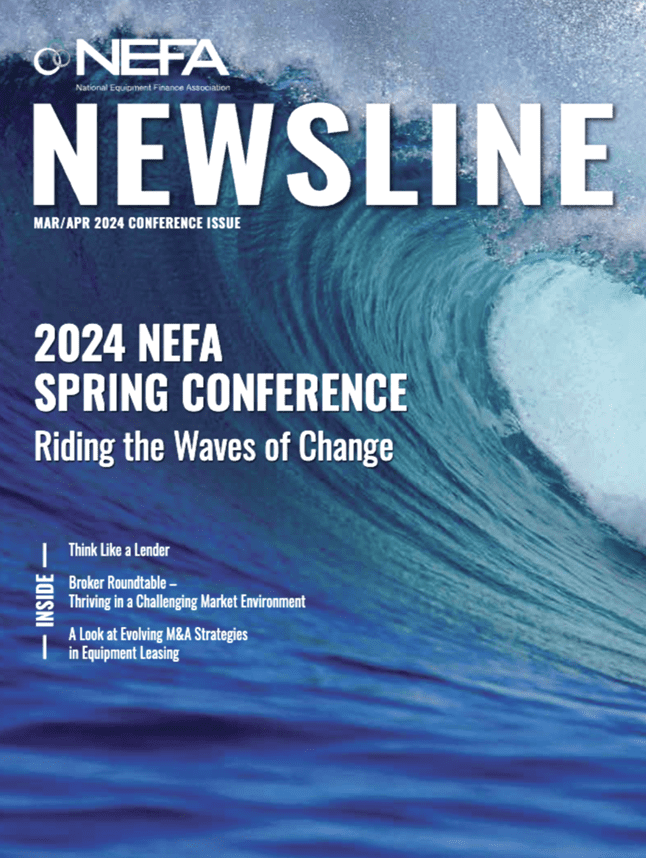Matching Equipment-as-a-Service Offerings to Market Needs

April 14, 2024
There is rising interest in Equipment-as-a-Service, but some in the equipment finance and leasing industry remain unsure about it, according to Diane Croessmann, a director at The Alta Group.
In a recent article in the March/April 2024 edition of the National Equipment Finance Association’s Newsline magazine, she takes a closer look at how Equipment-as-a-Service can meet the requirements of end users.
The term, commonly abbreviated as EaaS, defines an abundance of market offerings that range from bundled fixed-fee invoice structures to complex variable subscription algorithms, she writes.
“Although Equipment-as-a-Service was designed to address requirements created by a generation of subscription users, the ambiguity in using the EaaS reference contributes to healthy skepticism as to whether EaaS can gain sufficient momentum to compete with, or even surpass, traditional purchase, leasing or rental alternatives,” Croessmann writes.
EaaS offerings can vary substantially from industry to industry and between asset classes, but there are similarities, too.
“Unlike traditional financing, where the underlying asset is part of a financial contract between the end user and the funding source, Equipment-as-a-Service is a contract between an end user and a service provider,” she says. “Service providers are typically equipment manufacturers, distributors, value-added resellers or managed-service providers. Services embedded in the contract are designed to address end-user requirements for comprehensive bundles that include the use of the equipment, options for consumables, maintenance, software applications and other value-added components.”
Equipment-as-a-Service Benefits vs. Challenges
An Equipment-as-a-Service payment structure should be based on variable usage or successful output of the equipment.
“While true usage-based EaaS contracts have obvious benefits for end users, they present complex challenges for the service provider,” Croessmann writes. “In addition to end-user credit risk, a service provider must assess and mitigate risks created by underutilized EaaS assets, performance gaps and a balance sheet burdened with the underlying EaaS equipment.”
There are two categories of service providers: those who mitigate risk through third-party funding sources and those who choose to self-fund transactions.
EaaS is a highly variable usage or output-based structure, she says. Service providers looking to mitigate risk through third-party funding may have to make significant changes to end-user terms and conditions, such as eliminating end-user flexibilities, imposing usage minimums or establishing other fixed-payment commitments. In some cases, the final diluted EaaS contract more closely resembles a fixed-term lease commitment embedded into a more traditional services contract. This demonstrates how easily EaaS market requirements can be compromised to include a wide range of structures and offerings.
It’s a different dynamic for those who self-fund transactions and absorb EaaS risk, according to Croessmann. They are in a better position to leverage remanufacturing, secondary markets and other non-equipment revenue streams when balancing EaaS risk with offsetting opportunities.
“This puts them in a more strategic position to design EaaS structures that more appropriately address market requirements,” she says. “A key strength in a true EaaS usage- or output-based model is the ability to utilize sensor data to collect, monitor and analyze specific performance criteria. This would include the opportunity to leverage incremental revenue from these data streams.”
Unknowns with Equipment-as-a-Service
There is still much to learn about the dynamics of this subscription era, especially as manufacturers utilize technology to better meet market requirements. It remains to be seen how all of this will impact Equipment-as-a-Service, and ultimately the equipment financing industry.
“At the very least, we know that the current state of EaaS, where most offerings fall short of true EaaS market requirements, provides a misleading gauge for measuring EaaS demand and momentum,” Croessmann says. “We also know that the rapid deployment of sensor and AI technologies can effectively enable true EaaS.
“This will force more service providers to choose between addressing end-user requirements through self-funding options versus modifying contract terms and conditions to enable third-party funding. Third-party funders will need to re-examine risk guidelines to continue to effectively participate in these transactions. Lastly, it will require a different lens to examine market shifts from traditional financing to these alternative structures when transparency does not easily exist on service provider financial statements.”
Read Croessmann’s full article in the March/April 2024 edition of NEFA Newsline magazine, available here.
 |
Diane Croesmann is a director with The Alta Group. Her career has focused on designing, deploying and managing equipment leasing, financing and managed-services programs, both nationally and internationally. |
She and her colleagues at The Alta Group can help clients who require support in examining strategies for market entry, asset management, managed services, equipment as a service and a wide range of other activities that focus on developing and optimizing equipment leasing, financing and managed services opportunities.
Contact Diane Croessmann here.
Get Alta Insights,
written by our advisors delivered to your inbox.
By submitting this form, you are consenting to receive marketing emails from: The Alta Group. You can revoke your consent to receive emails at any time by using the SafeUnsubscribe® link, found at the bottom of every email. Emails are serviced by Constant Contact
